|
 History History
Legend has it that an
expectant mother had a dream in 832 in which her unborn son was seen
climbing a ladder to heaven. When he was born she named him Sorore and he
went on to found this hospital.
The earliest documents mentioning a
pilgrim's hospice here, attached to the duomo, date to 1090, with the current building dating from the 12th.
It grew rich on the donations of pilgrims who fell sick or died here. It's management
became more secular over time and broadened its remit to include the poor,
the infirm, the sick and foundlings, called getatelli or little
throwaways, and the donation of dowries to indigent maidens. By the 14th century, when the Blesssed Agostino Novello
wrote his statutes, the hospital was the second most important corporate
body after the commune, owning granaries, smaller hospitals and much land. With the suppressions of the 18th century Santa Maria dell
Scala became a hospital in the modern sense of the word - a place of
medical care, which it remained until 1975.
Interior
The ticket office and bookshop to the left of the façade are in what was
the Chapel of the Women's Wing, which
is still a vaulted space with frescoed scenes of the Passion of Christ
from the 15th century. There are also traces of a Madonna of Mercy
and a Holy Trinity with a kneeling nun, possibly the donor.
You will be given a map, but note that the floor where you begin is
the fourth. I suggest you start with the
Capella del Manto,
named for the fresco of
The Madonna della Misericordia which has been in the Capella del Sacro
Chiodo (see below) since 1610 - moved when a large doorway was added. This chapel was built in
the 14th century and originally called the Chapel of the Relics, for the
collection of relics, including a nail from the Crucifixion. The fresco decoration here on the
arches and vaults is 14th-century, with a (very Rosso Fiorentino-influenced) lunette fresco of The Meeting
of Anna and Joachim at the Golden Gate (1518) by Domenico Beccafumi.
During Santa Maria della Scala's time as a hospital this chapel was used
as the A&E department.
Into the passagio, the rooms on the right have changing displays. To the
left you enter the
Sala del Pellegrinaio
with walls covered with frescoes
by Domenico di Bartolo, Priamo della Quercia (brother of Jacopo) and Vecchietta of episodes
of the founding and work of the hospital
- unusually secular subject matter - painted from 1440
to 1444. Portraits of the hospital's rector, physicians and benefactors
can be found amongst the needy. This room has ever been the centre of the complex, first as a
reception room and later as a hospital ward, which it remained until the
1970s.
The
Sagrestia Vecchia
(see right) is further along to the left. It's also known as the
Capella del Sacro
Chiodo, because it once housed a nail (chiodo) used for
Christ's crucifixion. This may have suggested the subject of Vecchietta's
now very fragmentary, but impressive, frescoes here of 1446-9, which
depict the Articles of the Apostle's Creed, painted after his work
in the Sala del Pellegrinaio mentioned above. This is not the easiest of subjects to
interpret without captions, and one unusually centred on Christ himself,
rather than his mother, or the city itself, which are the more usual
subjects for such cycles in Siena. The 1444 high altarpiece by Domenico di Bartolo here
being more typical, as it depicts the Madonna della Misericordia,
with Sienese citizens protected under her cloak - the religious world is
to her right, the secular to her left. This is the fresco
originally in
the Cappella del Manto mentioned above, moved here in 1610 during
renovation work on the entrances. It was detached and moved here minus its two ends which were removed so
that it would fit the marble canopy
here. These fragments were reattached after they were found during
renovation work in 1969 and the sinopia (under drawing)
of the main panel is displayed on the right-hand wall.
The Old Sacristy now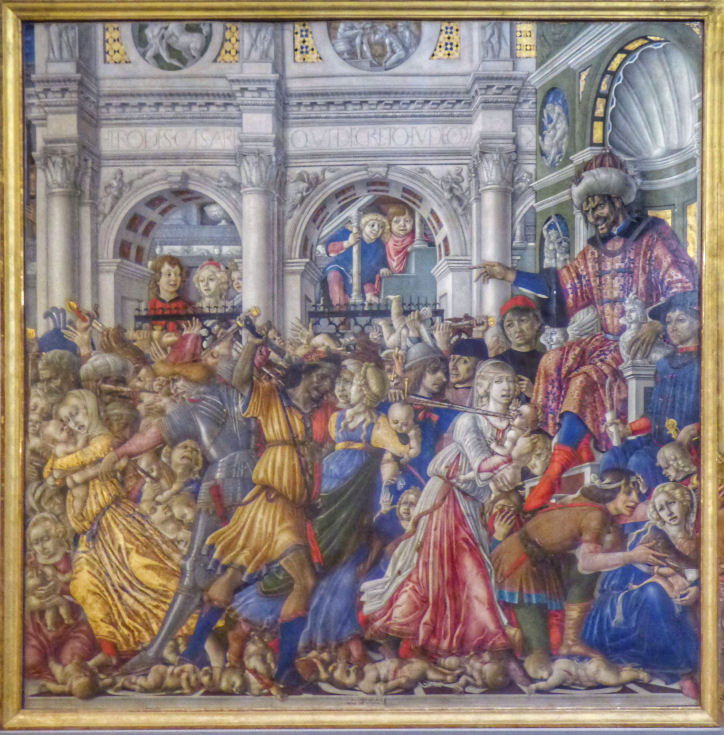 (April 2019) has glass cases full of the relics which
were displayed in the Capella del Manto when they where first donated in
1359, but moved here in the mid-15th century, when Vecchietta painted the
ceiling and walls and reliquary doors.
(April 2019) has glass cases full of the relics which
were displayed in the Capella del Manto when they where first donated in
1359, but moved here in the mid-15th century, when Vecchietta painted the
ceiling and walls and reliquary doors.
You then pass through the
baroque
Capella della Madonna,
built at the end of the 17th century with funds provided by one of the
hospital's nuns, Elisabetta Biagini, with stucco work and canvases by
Francesco Nasini. It also contains an odd and
disturbing Massacre of the Innocents of 1482 (see right) by Matteo di Giovanni (his speciality
- see
Santa Maria dei Servi) which has smiling children looking on the
carnage from
windows. It was originally in
Sant'Agostino.
And then it's on into into the suddenly enormous space of the
hospital church
Santissima Annunziata
(see right)
(Monday to Saturday: 9.30 - 12.00; 15.30 - 18.00). Its façade faces the Duomo's, so
that the church of the
Annunciation faces the church of the Assumption. It was rebuilt in the
late 15th century when its orientation was changed from east-west to north
south. It is high and boxy and a bit characterless but with an impressive
huge apse-filling fresco depicting the Healing of the Cripple at the
Pool of Bethesda, an appropriate subject, painted by Sebastiano
Conca in 1730. It replaced/destroyed the fresco of the Coronation of
the Virgin by Francesco di Giorgio Martini. There's also a Vecchietta statue of The Risen Christ
(1476)
topping the high
altar. The statue was part of his tomb in a chapel dedicated to the
Saviour that he designed for his own burial,
which was demolished during 17th century building work. He also painted a
large altarpiece for the chapel, of The Virgin and Child with Saints
Peter, Paul, Lawrence and Francis, now in the Pinacoteca. Frescoes by him had covered the walls before the rebuilding, but
his work in the Capella del Sacro Chiodo is now all that remains. A
Virgin and Child by Paolo di Giovanni Fei? The coffered ceiling
is the work of Francesco di Giorgio and painter Lotto di Domenico. The
altars are 17th-century.
Downstairs on level 3 a stripy and windowless pair of rooms lead to the
baroque, dark and windowless
Oratorio di Santa Caterina della Notte
(see below right) stucco-decorated in the 18th century, with two
more rooms beyond, the last of which, the sacristy, has a sudden triptych
of The Virgin and Child with four angels and Saints John the Baptist
and Andrew of c.1400/05 by Taddeo di Bartolo. A
panel of the Lamentation in the I Tatti collection, is very likely
from this work's predella. The two angels making music at the Virgin's
feet are the
Archangels Michael and Gabriel - the triptych was painted for the Compagnia di San Michele Arcangelo,
a charitable flagellant group who merged with a group dedicated to Saint
Catherine of the Night, named to celebrate the fact that Saint Catherine of Siena
would rest here between caring for the sick. There's also an 18th-century
statue of her sleeping here.
Also on
this floor is a vast space devoted to Jacopo delle Quercia's
Fonte Gaia, with eroded original bits and plaster reconstructions.
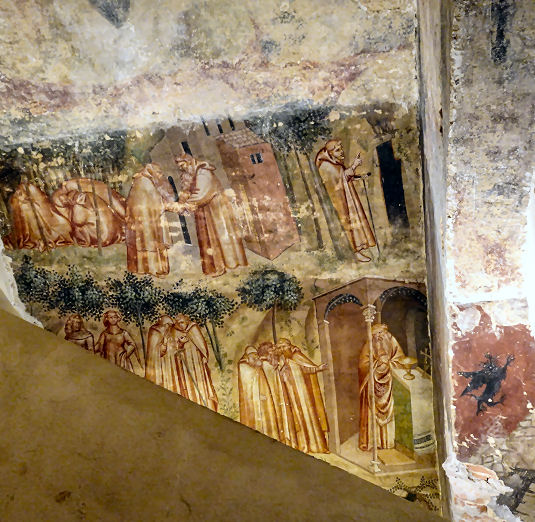

There's also a sequence of confusing
storerooms and crannies which used to house The Treasury
of
reliquaries (now in the
Sagrestia Vecchia as
mentioned above) that is weirdly lit and like a rough brick fairground
attraction, and by my
being mostly alone.
The next floor down (the Second Subterranean Level) has an oratory (see
below), frescoes
depicting the life of hermit monks revealed mid-14th century (see above), a covered road,
a local history museum, an archaeological museum
full of Etruscan stuff, a Charnel House (see left) and the
Wash House of the Wet Nurses to visit down here too.
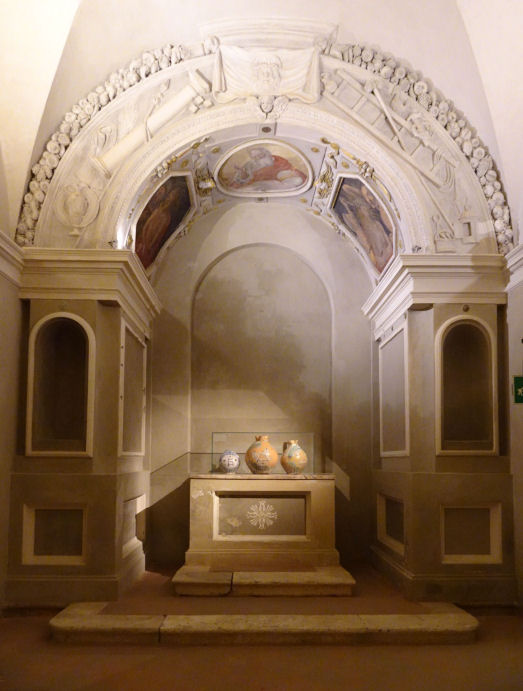
Lost art
The Virgin and Child with Saints Agnes, John the Evangelist, John the
Baptist and Mary Magdalene by Duccio is now Polyptych no. 47 in the
Pinacoteca. It would have stood on the high altar of the church of
Santissima Annunziata here, before the 15th century rebuilding, under Duccio's Crucifix.
A very influential cycle of frescoes of the Life of the Virgin
was painted on the façade of Santa Maria della Scala in 1335. Both
Ghiberti and Vasari describe the frescoes, with Ghiberti the most reliable
for having seen them himself. He says that Pietro
Lorenzetti painted the Nativity of the Virgin, and that his brother Ambrogio
contributed The Birth of the Virgin and The Presentation at the
Temple. Simone Martini painted The Marriage of the Virgin and,
as Ghiberti puts it, a scene where 'she was visited by many women and
virgins'. All are now lost - destroyed in the 18th century after a
protecting canopy was removed in 1720. See right for an artist's reconstruction.
A triptych of c.1340 by Ambrogio Lorenzetti, consisting of The
'Little' Maesta in the Pinacoteca with wings showing Saint
Nicholas of Bari Giving Alms, in the Louvre, and Saint Martin
Dividing His Cloak with a Beggar, in the Yale Art Gallery.
The latter is by far the most commonly depicted scene from the saint's
legend. As an eighteen-year-old Roman legionary, before becoming an
ecclesiastic, let alone a bishop, Martin encountered a naked beggar
outside Amiens and gave him half his cloak, later having a vision of
Christ wearing it. Yale Art Gallery.
The latter is by far the most commonly depicted scene from the saint's
legend. As an eighteen-year-old Roman legionary, before becoming an
ecclesiastic, let alone a bishop, Martin encountered a naked beggar
outside Amiens and gave him half his cloak, later having a vision of
Christ wearing it.
A gradual (cod.98.4) made for the Ospedale in 1344/45, with five mostly
Maryan miniatures by Lippo Vanni, is now in the Duomo Museo. See right
for one showing the Birth of the Virgin.
Three leaves from choir books commissioned for Santa Maria
della Scala between 1456 and 1477, illustrated by Pellegrino di Mariano
Rossini (MS 197) and Sano di Pietro (MS 196 & MS 198), are now in the
Fitzwilliam Museum in Cambridge. Four (vandalised) volumes remain in
Siena (MS 197 comes from one of them) and fragments from the rest are
dispersed around the world.
Giovanni di Paolo painted much for the hospital from the 1440s,
including altarpieces, banners and designs for the embroidery of
vestments. All that remains of these projects is the vivid altarpiece of
The Presentation at the Temple, now in the
Pinacoteca, painted for the guild of Pizzicaiuoli (grocers) and installed in
1447-9.
A Coronation of the Virgin painted for the apse by Franceso di
Giorgio and Guidoccio Cozzarelli is now lost.
The reliquary cabinet doors painted by Vecchietta (with help from
Pietro di Giovanni d'Ambrogio) in 1445/49 for the large sacristy here
(frescoed on the ceiling and walls by him), with twelve Sienese
saints and blesseds on the outer surfaces (whose relics would've been kept
in the cabinet) and eight scenes from
The Passion of Christ
inside (see right) is now in the Pinacoteca. Also in the Pinacoteca is a panel he painted for his tomb,
depicting the Virgin and Child with Saints Peter, Paul, Lawrence
and Francis. His bronze ciborium, made for the
high altar of the church of Santissima Annunziata here is now over the
high alter of the Duomo.
An Assumption panel by Ugolino Lorenzetti (an invented name for an
unknown artist midway between the styles of Ugolino da Nerio and the
Lorenzetti) is in the Pinacoteca. As is a Crucifix by Taddeo di
Bartolo and some fresco
fragments (including a sinopia) by Domenico di Bartolo.
A Trinity by Beccafumi, painted for the Chapel of the Mantle
c.1513, is now in the Pinacoteca.
Guide book
The Hospital of Santa Maria della Scala - a visitor's guide
by Ilaria Bichi Ruspoli (trans. Anna Piperato) (2016) is excellent -
well-designed, clearly-written and translated, and interesting.
Opening times
15 March to 15 October
Daily 10.00 am – 7.00 pm
16 October to 14 March:
(apart from 26 December – 6 January)
Monday, Wednesday, Thursday, Friday: 10.00 am – 5.00 pm
Saturday and Sunday: 10.00 am – 7.00 pm
Tuesday: closed
26 December to 6 January
Daily 10.00 am – 7.00 pm
Christmas Day: closed
|
|
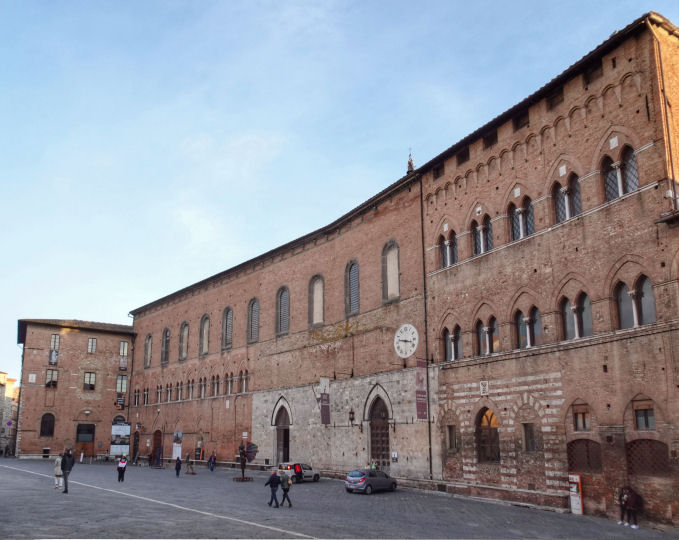
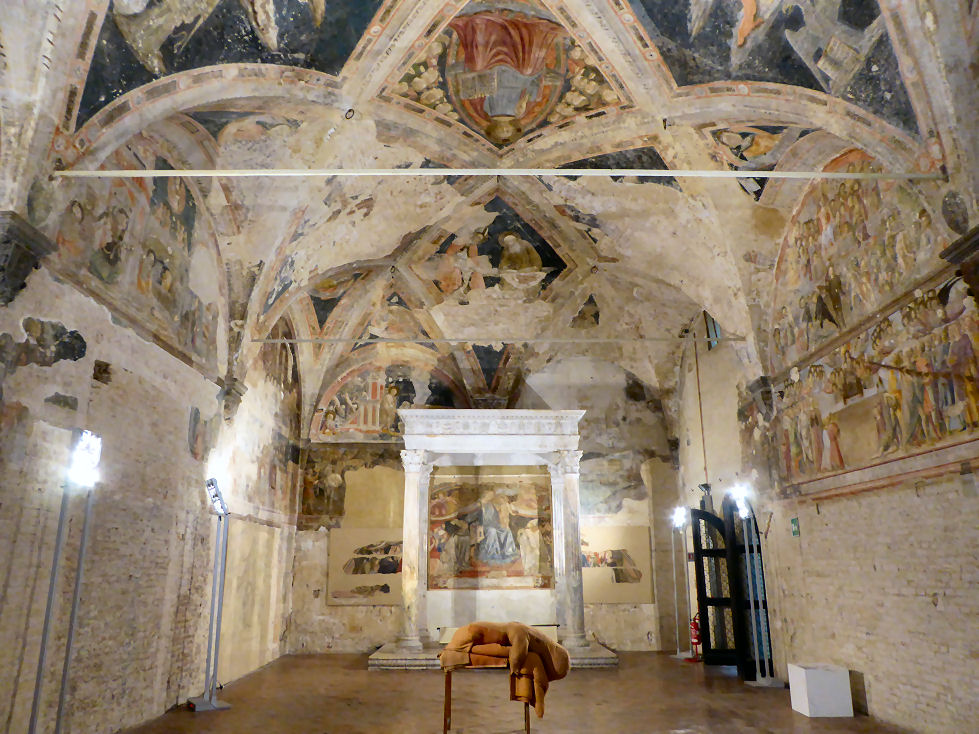
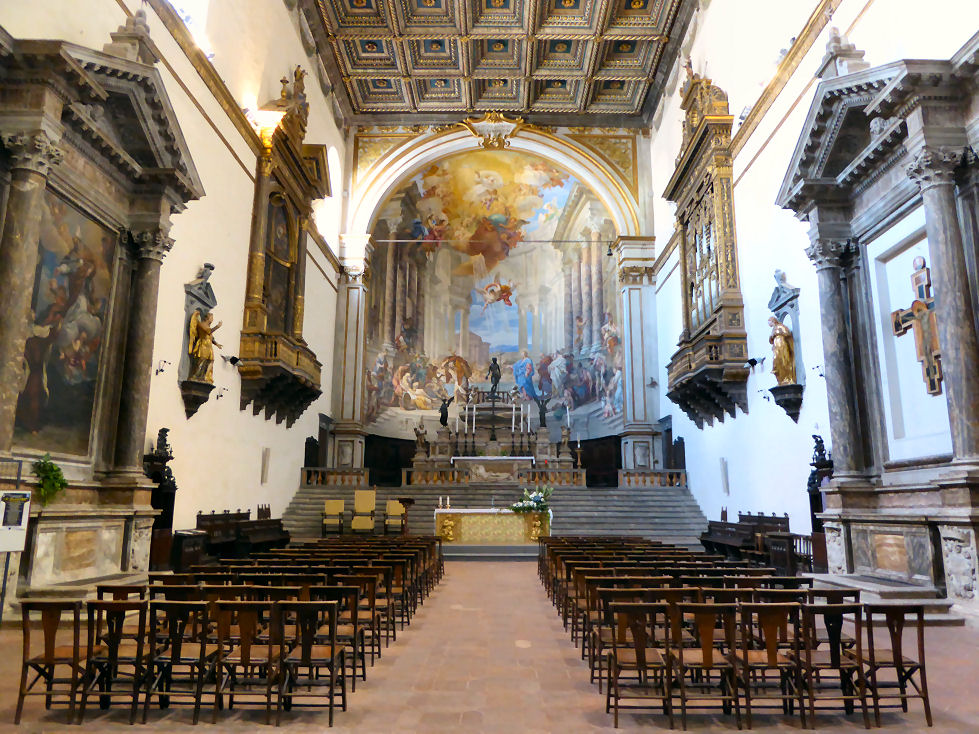
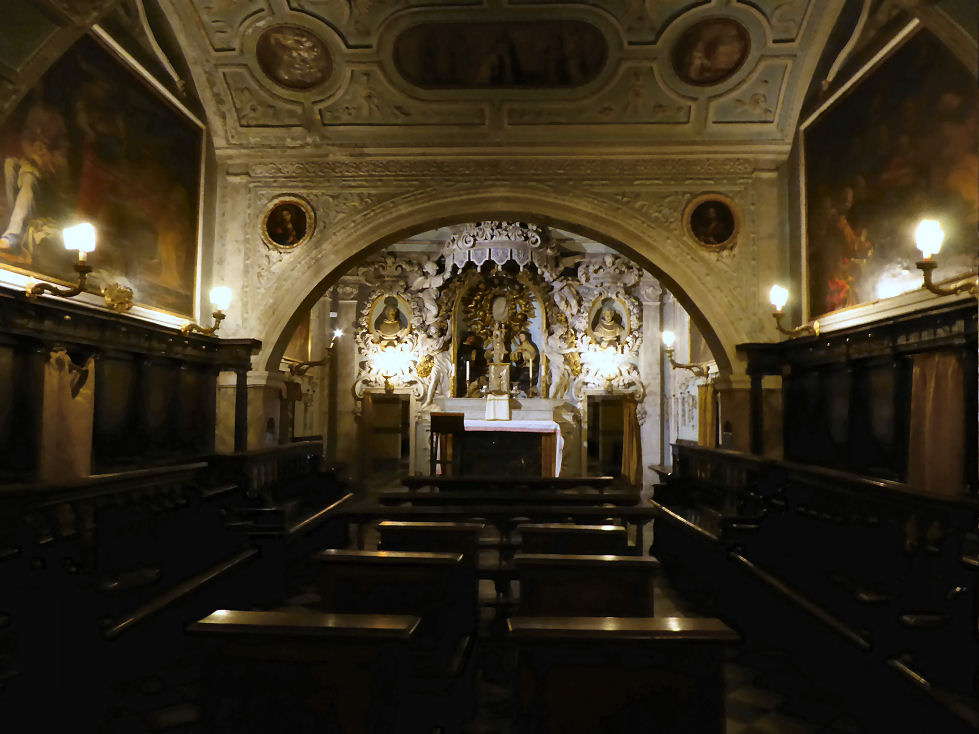
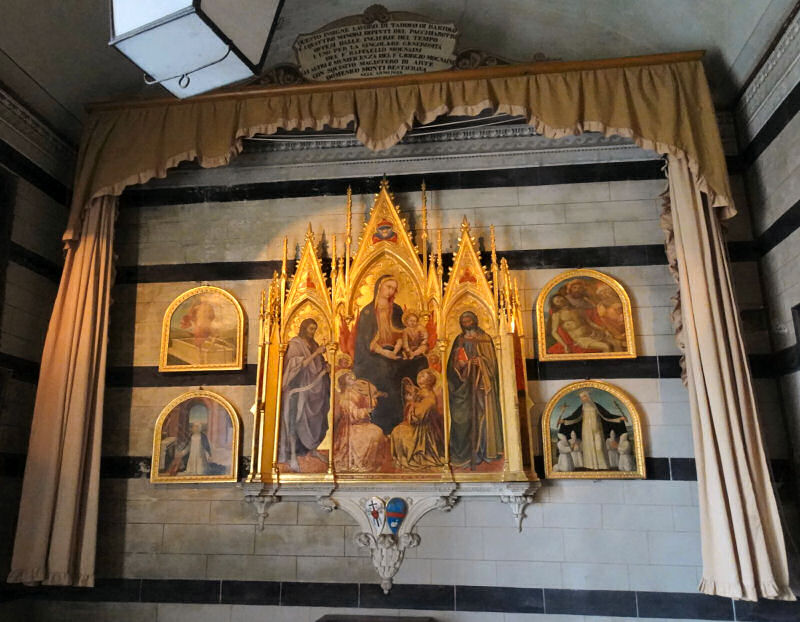
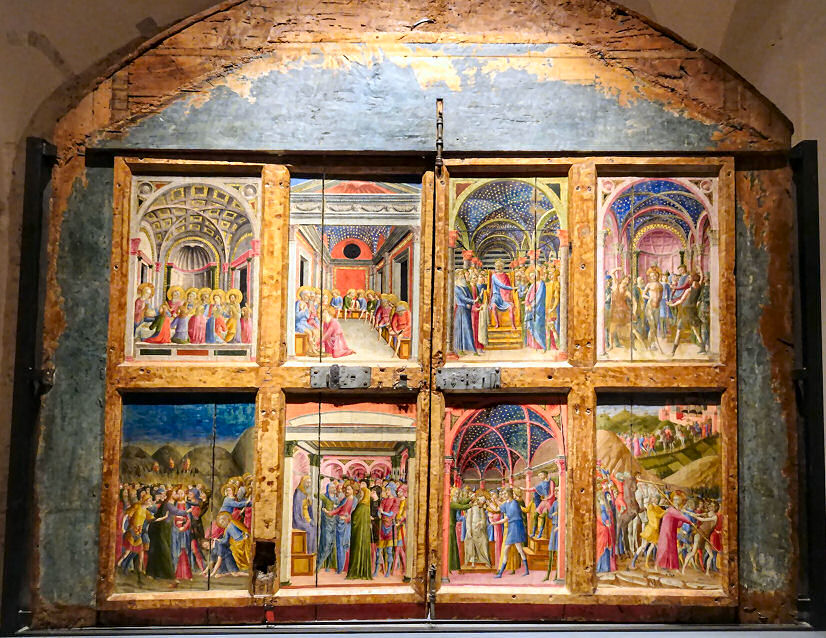
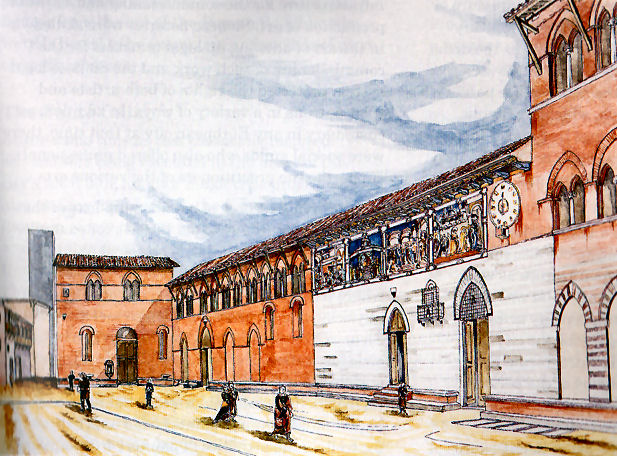
A reconstruction of the façade by Roberto Parenti,
from Barzanti's 'Storia di Siena'.
 |